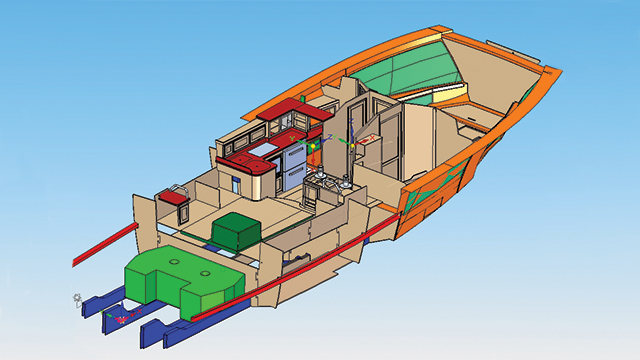Boat designers quickly capture customers’ preferences
Boat designers quickly capture customers’ preferences

Synchronous technology in Solid Edge provides Back Cove Yachts an unprecedented level of design fine-tuning by enabling them to rapidly capture customers’ preferences.
Lobster boat heritage
With design elements such as spoon-shaped bows and gently sloped transoms, Back Cove Yachts reflect their Maine lobster boat heritage. But unlike their predecessors, these modern yachts feature ample room in the cockpit as well as cabin amenities such as refrigerators and freezers, microwave ovens, stainless steel sinks, plenty of storage and comfortable sleeping accommodations. Large windows provide ample visibility and light. Performance is up-to-date as well, thanks to modern, deep-vee hulls and six-cylinder diesel engines.
Back Cove’s elegant, traditional boats are built by 100 of Maine’s finest boat builders in a modern 240,000 square foot facility. The current product line-up includes four models from 26-37 feet long, all of which cost considerably less than most other boats of this type. The boats are sold through a worldwide dealer network.
Capturing customer and dealer input
With the exception of the molded fiberglass surfaces, which are imported from a surface modeling program, all design work is done in Siemens Solid Edge software, leveraging its synchronous technology to address the customer-driven nature of the company’s design process.
“When we’re designing a new model, we send out preliminary sketches to our dealers and they send back suggestions based on what they know our customers want,” explains Adam Carlson, a design engineer at Back Cove Yachts. What this means for the design process is that a boat’s layout changes many times before a design is finalized. “Our dealers are all over the world and their input is all different, so we try to find a happy medium,” Carlson explains. “In doing that, we’re constantly changing and tweaking the design. Something like a bulkhead might move a dozen times throughout the design process.”
The bulkhead move that Carlson mentions might be as little as half an inch, but previously even a minor change such as this would have been a time-consuming process, requiring him to remember how the element had been modeled before making any sort of change. That was a history-based approach to modeling and it sometimes proved difficult at Back Cove Yachts. “Because of our lean design and engineering process, there are times when I might not use Solid Edge for two or three weeks where I’m busy doing other things,” Carlson says. “With synchronous technology, I don’t have to go back and think, ‘How did I create this model?’ I just grab the steering wheel and edit the design on the fly.”
